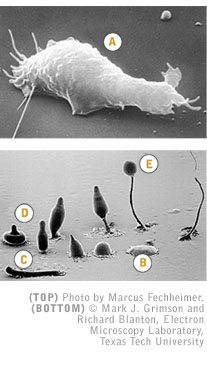


Life of Slime
by Kathleen Cason

What Goes Wrong
in Alzheimer's Disease
![]()

It may look like a Dr. Seuss creation, but this microscopic slime mold (figure A) has helped scientists, like UGA cell biologist Marcus Fechheimer, answer many questions about the life inside cells.
This peculiar life form — called Dictyostelium discoideum — shares biochemical similarities with a broad range of plants and animals, making it ideal for research. For example, its sensory system detects and responds to chemical information in its environment much the same way as the human sensory system, Fechheimer said.
“It turns out that’s how our eye works, that’s how our nose works, that’s how our taste works,” he said. “It’s the same system used for adrenalin responses, when you get excited. You can study it in people or you can study it this little mold.”
The slime mold has an odd life. Normally, single-celled, amoeba-like individuals that resemble microscopic globs of Jell-O move about by extending slim, finger-like projections that grip a nearby surface and drag the cell forward (A). Portions of a cell’s outer membrane periodically flare out in the shape of a cup, scooping up and swallowing a favorite treat — bacteria. But when food gets scarce, up to 100,000 individuals “find” each other (B), join together and form a slug-like critter as big as a grain of sand that glides along (C), looking for a good place to settle and make reproductive spores. When this makeshift slug finds a good spot, it “squats,” looking somewhat like a sombrero as cells take on distinct jobs (D). Stalk cells elongate and then die, sacrificing themselves to raise the fruiting body cells high enough so that spores can catch a breeze when they’re released (E).
One of the photographers for the composite image at left is University
of Georgia alumnus Larry Blanton, now a professor of cell and developmental
biology at Texas Tech University.
— KMC
For comments or for information please e-mail the editor: jbp@ovpr.uga.edu
To contact the webmaster please email: ovprweb@uga.edu
![]()